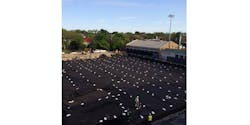Building the newest practice athletic field at Tulane University in New Orleans would seem straightforward enough. But outside factors such as constrained real estate, the need to account for storm water and New Orleans’ high water made construction of the field a challenge.
Designers from Gould Evans Associates and Lee Ledbetter & Associates needed a way to store storm water runoff from the adjacent Yulman Stadium field while maximizing the limited area for the Barney Mintz Practice Field. They chose to design a storage chamber under the new Mintz practice field. This in turn posed a dilemma: how to get enough storage in the limited space and deal with the high-water table.
While looking for solutions, the design team found an easy solution to one of the problems: a modular and stackable storm water storage product called Rainstore3. This product has 94% void space for a high storage-to-volume ratio and could account for the 50,000 cu ft of storm water runoff generated from the surrounding area while still fitting in the area below the practice field.
Rainstore3 is manufactured by Invisible Structures of Golden, Colo. It is a unique structure with one unit consisting of 36 cylinders connected via a grid. Each unit is 1 meter square and 10 cm high. The units then are stacked to various heights and the stacks are nested into adjacent ones. This modularity and versatility was just what the Tulane team needed. For the university field, they ended up with one chamber with two areas of differing heights. The majority of the chamber section placed directly under the field was five units high (50 cm) and the additional area was stacked seven units high (70 cm). The final design consisted of 14,286 units.
This still left the second and perhaps most difficult problem to solve. Precautions had to be made in the design of the system, as the water table will exert upward buoyant force on the chambers at different times. The Tulane design team wrapped all four sides and the bottom of the chamber with an impermeable membrane. The top of the chamber was only wrapped with a geotextile fabric to allow for direct storm water infiltration.
Calculations were made to see how buoyant the impermeable liner made the Rainstore3 chamber system. Then designers could counteract the upward buoyancy pressure with static pressure from the cover material and athletic field surface turf, preventing the system from “floating” or popping up. The static pressure adjustment was achieved with a cover of base course varying from 10 to 19 in. and the artificial turf surface and drainage rock varying from 1 to 2 in.
Embedded in the base course, 10-in. perforated pipe was connected to the chamber at all four corners to aid in water conveyance and extended beyond the footprint of the storm water storage chamber. Additional inlet grates are piped into the chamber from other impermeable areas and the chamber is directly connected to the subsurface drainage of the neighboring Yulman Stadium Sports Field.
The Rainstore3 chamber was installed in May 2014 by Durr Heavy Duty Construction and has had one full football practice season as a successful test.
